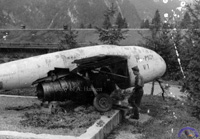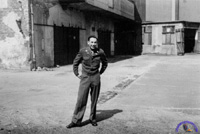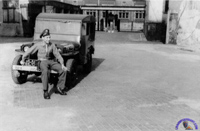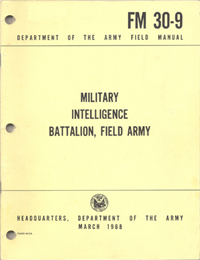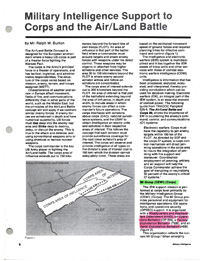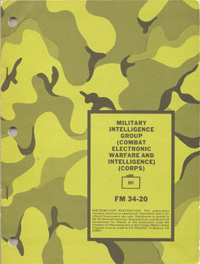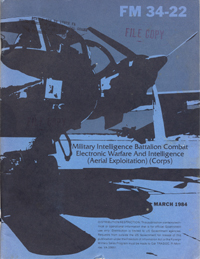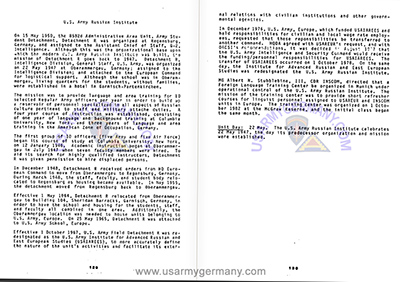| If you do
NOT see the Table of Contents frame to the left of this page, then
Click here to open 'USArmyGermany' frameset |
||||||||||||||||
|
Military Intelligence Organization in Theater |
||||||||||||||||
|
|
||||||||||||||||
|
||||||||||||||||
|
|
||||||||||||||||
| The Early Years (1945 - 1960) | ||||||||||||||||
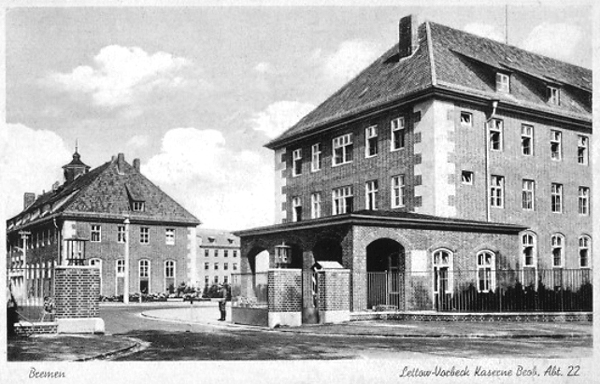 Bremen Barracks (Lettow-Vorbeck-Kaserne) in a pre-WWII German postcard |
||||||||||||||||
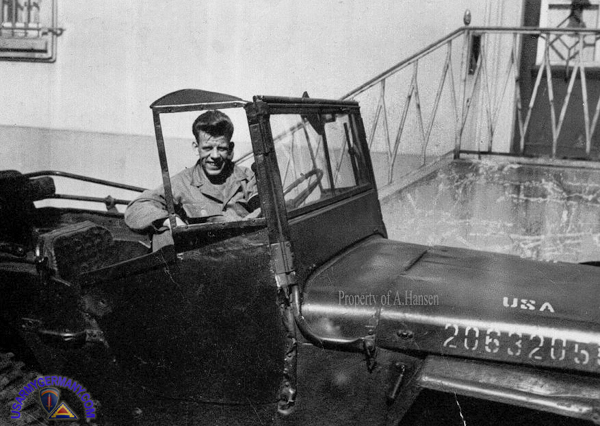 Arthur Hansen sitting in jeep in front of 7854's Hohenlohestrasse office |
||||||||||||||||
| 1947 | ||||||||||||||||
| (Source: Email from Arthur Hansen) | ||||||||||||||||
| I served with 323rd Mil. Int. Det, in Bremen, Germany. We were billeted at Bremen Barracks. In late 1947 it became 7854 Mil Int Det as Interrogator (in German). Our subjects were Ex POW returning from the Iron Curtain; Refugees; German Volkspolizei deserters. Very active during the Berlin Airlift and much, much more. I have a few photo's from my time in Bremen Our unit of 13 men handled 37 languages. I was (originally) assigned from the replacement depot at Marburg am Lahn to the 322nd M.I. in Bremen in late June of 1947. Within days I was sent to the Intelligence School in Oberammergau ; this was in the former Messerschmitt facility. Upon my return from the school, the 322nd M.I. was changed to the 323rd M.I. detachment. The 323rd existed until 1948 when it was redesigned as the 7854 MI Det. Our office was located at 44 Hohenlohestrasse at the Hotel Zur Post (near the Bahnhof) and our field office was at the Bahnhof where incoming refugees, Ex P.O.W.'s, deserters and Displaced Persons would come to our field office to receive I.D. and ration cards. While there they were interviewed. One of our men would screen for possible valued intelligence and if warranted they were sent to the main office at 44 Hohenlohestrasse for interrogation. All positive information were forwarded to H.Q. in Heidelberg. |
||||||||||||||||
|
||||||||||||||||
| 1955 | ||||||||||||||||
| (Source: various) | ||||||||||||||||
| US ARMY INTELLIGENCE IN THE 1950's In 1955, the Army transferred positive collection functions previously performed on an ad hoc basis by CIC to the new discipline of field operations intelligence. In 1957, new types of tactical intelligence units were organized under the Military Intelligence Organization (MIO) concept. In MIO units, CI personnel were integrated in a single unit with positive intelligence collectors for the first time to support tactical commanders. This instituted a trend towards multidiscipline intelligence units which would ultimately culminate in the CEWI units that were formed at the end of the 1970's. |
||||||||||||||||
| (Source: Chapter 3, US Army Border Operations in Germany, 1945-1983, by Willaim E. Stacy) | ||||||||||||||||
INTELLIGENCE MISSION ON THE BORDER (1950-1952) Seventh Army was responsible for collecting by noncovert means intelligence within the US Zone pertaining to the physical security of zonal borders adjacent to the Soviet Zone and Czechoslovakia. This function was carried out by the 7827th Military Intelligence (MI) Service Company, which had MI sections assigned along the border to facilitate its collection mission. Illegal border crossers apprehended by American troops were turned over to the 7827th sections for interrogation. It also compiled the information gathered by noncovert means by the border patrols. Its most important function was its close liaison with the German border police agencies, which captured the lion's share of illegal border crossers and passed on information of intelligence value to the 7827th. The unit was redesignated as the 532d Military Intelligence Service Company on 15 August 1951 and redesignated and reorganized as the 532d Military Intelligence Service Battalion on 21 September 1951; it continued to work directly for the Seventh Army G-2, as had the 7827th MI Service Company. The counterintelligence mission in the US Zone belonged to the 66th Counter Intelligence Corps (CIC) Group, with its 427th Counter Intelligence Corps Detachment providing this service to the Seventh Army. The 427th CIC Detachment, in addition to its overall counterintelligence mission, investigated border incidents, conducted border liaison between the US and Soviet Zones, and interrogated illegal border crossers and German prisoners of war returning, from the east. As can be seen from the above, there was some overlap in missions between the two organizations -- particularly in the interrogation of illegal border crossers. Several conferences were held in the first half of 1951 between these two organizations and other interested parties, and it was decided that beginning on 1 October 1951 the 532d Military Intelligence Service Battalion would be responsible for centralizing American collection efforts from illegal border crossers (IBC). Since this unit made most of the initial contacts with the IBCs apprehended by American patrols and had a close liaison with the German agencies, it was a natural choice. The unit was responsible for making up identification cards on the IBCs and ascertaining their knowledge ability in various fields of intelligence (e.g., ground military, air, naval, political, economic, or scientific and technical), and to notify the agencies primarily concerned with that type of information. This single point-of-contact method made for a significant improvement in liaison with the German agencies. |
||||||||||||||||
| The 1960s | ||||||||||||||||
| (Source: various) | ||||||||||||||||
| US ARMY INTELLIGENCE IN THE 1960's At the beginning of 1961, the Army's CIC was merged with field operations intelligence assets to form a consolidated US Army Intelligence Corps. In Oct 1961, the joint-service Defense Intelligence Agency was formed. |
||||||||||||||||
| 1968 | ||||||||||||||||
| (Source: FM 30-9, Military Intelligence Battalion, Field Army, March 1968) | ||||||||||||||||
|
||||||||||||||||
|
|
||||||||||||||||
| The 1970s | ||||||||||||||||
| (Source: various) | ||||||||||||||||
| US ARMY INTELLIGENCE IN THE 1970's At the end of 1974, the Army Chief of Staff directed the Intelligence Organization and Stationing Study (IOSS) which led to the most sweeping reorg of military intelligence since the end of WWII. The IOSS report was released in 1975. |
||||||||||||||||
| The 1980s | ||||||||||||||||
| 1981 | ||||||||||||||||
| (Source: Military Intelligence Journal, September-October 1981) | ||||||||||||||||
| 1983 | ||||||||||||||||
| (Source: FM 34-20, Military Intelligence Group (CEWI)(CORPS), May 1983) | ||||||||||||||||
|
||||||||||||||||
| 1984 | ||||||||||||||||
| (Source: FM 34-22, Military Intelligence Battalion (CEWI)(Aerial Exploitation)(CORPS), March 1984) | ||||||||||||||||
|
||||||||||||||||
| US Army Russian Institute (previously Detachment "R") | ||||||||||||||||
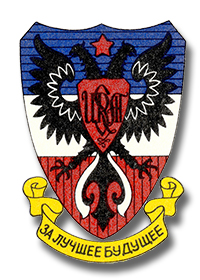 Russian Institute insignia Russian Institute insignia |
||||||||||||||||
| (Source: Email from Joe Clare) | ||||||||||||||||
| One of the units resident in Regensburg between December 1948 and May 1955 was Detachment R -- the US Army school that was established after World War II to provide language and area studies training for US military and State Department officers who would be dealing with the Soviet Union and its East European allies. Detachment R was originally set up in Oberammergau in May 1947 but moved to Regensburg in December 1948 because of the limited housing available in the Oberammergau area. When the housing situation improved, Detachment R returned to Oberammergau in May 1955 and later, in May 1964, the school relocated to Sheridan Kaserne in Garmisch. During Detachment R's time in Regensburg, several students who would later become General Officers or US Ambassadors studied there, including BG Donald Blake (USAF), MG Clark Baldwin, Jr. (USA), LTG Sam Wilson (USA), Ambassador John McSweeny, and MG Charles Timmes (USA). Commandants of Detachment R during its time in Regensburg included LTC Theodore F. Hoffman, LTC Albert Martin, LTC Kenneth Lemley, and LTC Ladislaus Maslowski. |
||||||||||||||||
| Related Links | ||||||||||||||||
|
||||||||||||||||

